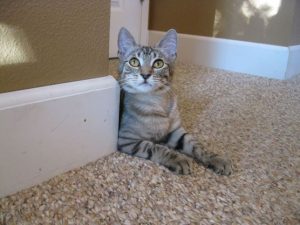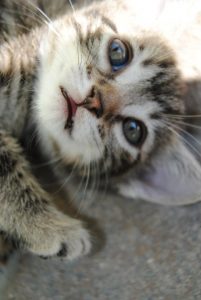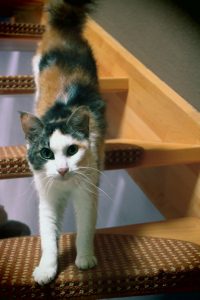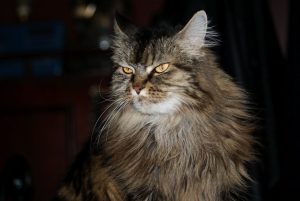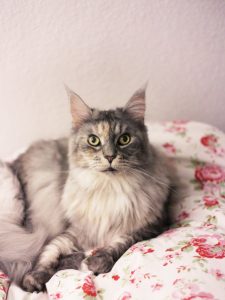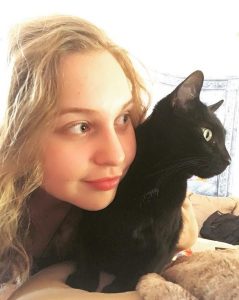Egyptian Mau
Most assume that the Egyptian Mau has its given name due to the cat’s origins, initially believed to be found in Egypt. However, through DNA tests, it was discovered this breed originated in Europe. Due to the fact that sailing through the North, Atlantic, Tyrrhenian, Black, Mediterranean, and the Red Seas became frequent during that era, many cat breeds traveled by ship to new destinations all over Europe, Africa, and the Middle East. This breed was given their name because they were largely celebrated and worshiped by the Ancient Egyptian kings and pharaohs. “Mau” means “cat”, and it also means “sun” in Ancient Egyptian. These cats were typically viewed as gods and judges to their royal families.
These cats came to the United States in 1956 when the Russian Princess, Nathalie Troubetskoy imported her three famous Maus from Italy; a bronze male and two silver females named JoJo, Liza, and Baba. The breed achieved “champion” status with the International Cat Association in 1979. Some British cat breeders tried to create Maus by cross-breeding Tabbies, Abyssinians and Siamese cats, but this proved to be unsuccessful because they lacked the Egyptian Mau’s discrete physical attribute; an ‘M’ or “Scarab Beetle” on their foreheads. The cats from the failed breeding attempts were given the name Ocicat in the mid-1960s.
Maus are known for many characteristics; agility, gentility, livelihood, loyalty, playfulness, and of course, their intelligence. Their intelligence is responsible for their indisputable loyalty to their humans, also making them serine and irresistible to be around. Maus will pick their special human with whom they express their utmost devotion and affection to. But fret not, if you have a Mau, they will also be loving to the rest of the household; one person will just be showered with a little extra attention. The breed also proves to be highly intelligent due to their curiosity and friendly attitude towards strangers. They enjoy being in high places, claiming their territory and watching their house-mates wander among their home. Maus can often be found on top of refrigerators, cat trees, or cupboards, and they spend much of the time riding on their owner’s shoulders.
Nicknamed the “Pharaoh Cat” Maus have silky short coats with a color range from Smoky, Black, Silver, and Blue. The word “Mau” also means natural, as this breed is the only naturally spotted domestic cat. This breed has a maximum life expectancy of twenty years, and minimum of eighteen. Male Maus should weigh between ten to fifteen pounds, and females should weigh between six to ten pounds. This breed is very vocal, highly active and playful. An average cost for an Egyptian Mau kitten can range from $500 to $800 US dollars.
LaPerm
The LaPerm cat was given its name for having a tight, curly coat, emerging in the 1980’s from a unprompted mutation of cats bred for nuisance control (mouse hunters). Breeders Richard and Linda Koehl from Oregon had a cat that gave birth to a curly-coated kitten, who they then named Curly. Curly then bred with Manx and Siamese cats, and her litter of kittens all shared the dominant mutation of the curly coat, making Curly the ancestor of all LaPerm cats. The breeders let their curly cats continue to breed freely over ten years before they contacted the breeding programs and making them official with The International Cat Association in 1995, and eventually Championship status in February 2003.
Nearly all LaPerm kittens are born bald with tabby-like patterns on their skin, with a curly coat beginning to develop within three to four months. Despite the curls ranging from corkscrew to ringlet curls, the coat has a very uncommon texture. Often described as soft, there is no thick undercoat and the curls are typically loose. These cats will need more grooming than straight haired cats. LaPerms also have their curls inside and behind their ears, with long, curled whiskers on their face with coat colors varying from red, black, lilac and chocolate.
Known for being very cleaver, LaPerm cats can be funny and mischievous critters. They use their paws to swipe for food, open doors, and tap their owners for attention. They are moderately active and are typically very good at playing fetch. LaPerms won’t follow your every step, but they might sit on the top of your desktop, lap, or shoulders. Rarely using their voice, they are very quiet, patient, and gentle with all people. LaPerms are happy lap cats that are naturally inquisitive and curious to know what happens in their surroundings. Owners of this breed report that their LaPerm cats are empathic to their needs and emotions. Because they are tuned to their owner’s senses, owners form deep bonds with their LaPerm cats.
This breed has a maximum life expectancy of fourteen years, and a minimum of ten years. Male LaPerm’s maximum weight should be at ten pounds and a minimum of eight, and females max weight is at eight pounds while their minimum is five. These kittens can cost between $400 to $600 US dollars if purchased directly from breeders.
Maine Coon
The Maine Coon cat is one of the oldest breeds from North America and there have been many speculations about how this cat came to be. To raccoons and feral cats mating, an attempted escape by Marie Antoinette with her six Turkish Angora cats, from English captains having long haired cats that would land in New England, these cat’s origins have remained a mystery. The breed emerged in popularity in the early 1860’s, and in 1895 twelve Maine Coons were entered into a cat competition, and a female brown tabby Maine Coon named Cosey won the silver collar and was named the Best Cat in the Show. After a cat show in 1911, the breed was rarely seen in competitions. They were originally denied provisional breed status by the Cat Fanciers’ Association in the early 1970’s, but five years later, the breed was finally given the status and the State of Maine declared the Maine Coon as their Official State Cat.
As either a long or medium haired cat, their coats are silky soft but have different textures depending on the color of their coat. Maine Coons can have any color of coats that other cats have. Although the tabby pattern is quite common among this breed, they can also have a solid colors ranging from bi-colored coats to solid white, cinnamon, or black. These breeds are the largest breed of domestic cats; in 2010 a Maine Coon named Stewie made the record as longest cat, measuring at 48.5 in (about 4 feet long) from his nose to his tail. Their bodies are muscular and their bone structure is solid to support their weight. They continue going through puberty until they are about five years old, their body constantly growing, while other breeds usually take about a year or two to reach their maximum weight.
Owners of Maine Coons report that their cats are so intelligent that they’re easily trainable like dogs. Not only are they loyal to their families, but they have no problem with giving their owners hours of their time; they tend to enjoy being a part of everything that their family is doing. They are human oriented cats and they often approach strangers in a friendly manner. It should be easily to train these cats to walk on leashes and harnesses, and to teach them to play fetch. Maine Coons are one of the few breeds that remain kitten-like for most of their lives, making them good-natured, and they are only vocal when they are hungry, or when that desire attention from their humans. Unlike some cats, Maine Coons adore water; they love to be in it, wash their food in water, watch it, or play in it
Maine Coons have a maximum life expectancy of thirteen years and a minimum of eleven. It is important to make sure these breeds don’t become overweight; males have a maximum weight of fifteen pounds, a minimum of twelve, and females have a maximum weight of twelve pounds and a minimum of nine. The cost of Maine Coons kittens can vary depending on the area, making them more expensive if they are purchased from the West and East Coast, ranging from $400 to $1,000 US dollars.
Elanda-Isabella Atencio, our Feline Editor, is on her road to being a “crazy” cat lady. She has three cats; a moody Missus, a wild Baby Kitty, and notorious Fredrick Douglass. She was raised with cats, chickens, dogs, and geese. From cleaning coops, morning dog runs, picking eggs, to growing catnip, Elanda enjoys pampering her pets. Elanda is a student at New Mexico State University, earning her BA in Creative Writing and is Editor-in-Chief of the online arts journal, Independent Noise and reader for Puerto del Sol. She plans to move to Oregon, where she hopes to take her cats on daily walks when it’s overcast and cool. If you’d like to contact Elanda, email her at eincatencio@gmail.com.

